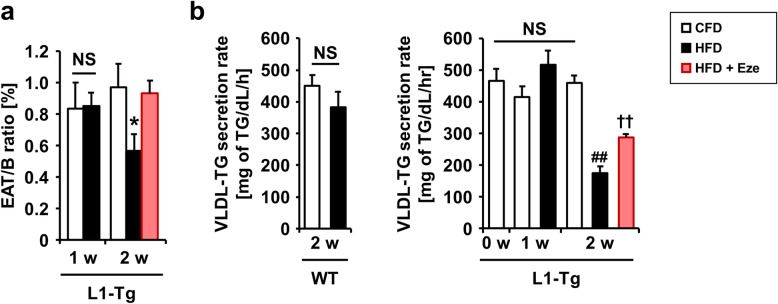Fig. 4.
Biochemical characterization of hepatic NPC1L1-mediated steatosis in L1-Tg mice. a The ratios of epididymis adipose tissue weight to body weight (EAT/B ratios) in L1-Tg mice fed a control-fat diet (CFD) or high-fat diet (HFD) in the absence or presence of ezetimibe (Eze). w, weeks. n = 4 (CFD), 7 (HFD) [1 w]; 6 (CFD), 8 (HFD), 4 (HFD + Eze) [2 w]. b Effect of HFD feeding on very low-density lipoprotein-triglyceride (VLDL-TG)-secretion rates. As an index of the lipid-efflux rate from the liver to blood, we determined VLDL-TG-secretion rates in WT (left) and L1-Tg mice (right). n = 4 (CFD), 7 (HFD) [2 w] in WT mice: 4 (CFD) [0 w]; 4 (CFD), 7 (HFD) [1 w]; 6 (CFD), 7 (HFD), 4 (HFD + Eze) [2 w] in L1-Tg mice. Data are expressed as the mean ± SEM. Statistical analyses of significant differences among the groups in each category were performed using a two-sided t-test [NS, not significantly different between groups in (a) and (b, left); ††, P < 0.01 vs. 2 w-HFD group in (b, right)] or Bartlett’s test, followed by a Dunnett’s test [*, P < 0.05 vs. 2 w-CFD group as a control in (a; all 2 w groups)] or a parametric Tukey–Kramer multiple-comparison test [##, P < 0.01; NS, not significantly different among groups in (b, right; all non-ezetimibe groups)]

